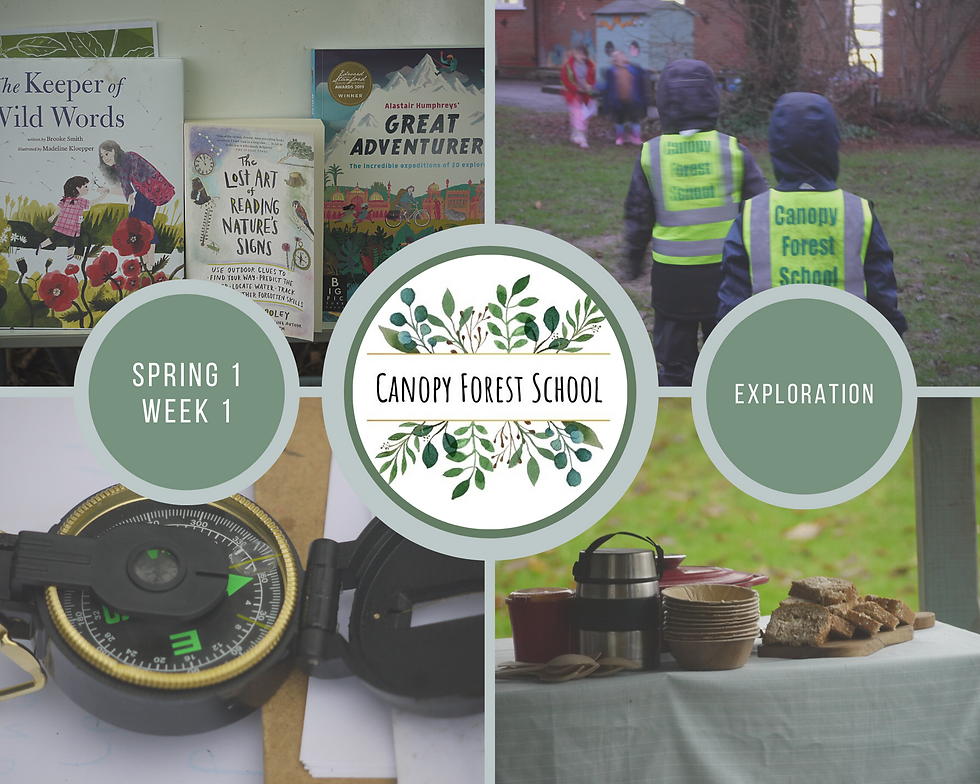Differentiate between broad leaved and coniferous woodland ecosystems.
- ejejones

- Jul 14, 2020
- 4 min read
The ecosystems within broad leaved and coniferous woodlands vary and differ in a number of ways. These differences will greatly affect the experiences and explorations that could take place during a Forest School programme. This week I have thoroughly enjoyed exploring these differences and learning more about the native trees of Great Britain and the ecosystems that exist in both broad leaf and coniferous woodland.
During this assignment I have ventured into two very different woodlands one being coniferous (Ampfield wood) and the other being mainly broad leaf (Bently Wood). I have looked more carefully at the soil, measuring the temperature, ph levels and moisture at both sites and also the vertical and horizontal structures. I have also learnt a lot about the ecosystems at both sites and discovered more through my reading of the important part that each species plays in making each site unique and special.
Broad leaved woodland as the name suggests consists of broad leafed trees and these are characterised by broad leaves in a variety of shapes. These are as Starr asserts are “usually but not always, deciduous and function for only one season, dropping their leaves in autumn. These trees store their reserves of energy and nutrients in the roots and branches ready for the spring” (Starr, 2009, p38). There are seven common native British broad leaved trees and these are:
Ash
Common beach
Elm
Silver birch
English oak
Sessile oak
Silver birch
White birch
Broad leaf forests are the dominate habitat of the UK and most of temperate Europe. These forests have a rich biodiversity but are now commonly man made and planted. Today there is little left of Britain’s ancient woodland. These woodlands have a four tear system or vertical structure that leads to a large biodiversity and ecosystem. In broad leaf woodlands in Britain, high light levels reach the ground for several months once the trees lose their leaves in the autumn and this means that in the autumn and spring, species in the lower woodland layers have the opportunity to grow in the higher light levels.
In contrast to broad leaf woodlands, there is no period when the trees lose all their needles in coniferous woodland. This is because the trees are mostly evergreen (with the odd exception, such as Larch). As a result, there is no seasonal period when unobstructed light reaches the woodland floor. The plant species which require more light to produce flowers will be excluded from darker coniferous woodlands. As Starr states in his books Woodland Management:
“Coniferous woodlands are less advanced than broad leaves. A conifer has leaves that are neither needles nor scales; the leaves of most conifers remain on the tree from 2-6 years and continue growing throughout the year. Although most conifers are "evergreen" some are deciduous and lose their leaves over winter for example the Larch“(Starr, 2009, p22).
Most trees found in Broadleaf Woodlands are native to Britain whereas in Coniferous Woodland, there is only the Scots Pine and the Juniper and Yew (which are usually shrub species) that are native to Britain, the rest of the species have been imported over the years. Coniferous woodlands are usually planted to meet specific needs. The trees in coniferous woodlands grow at a similar rate and the canopy rises equally forming a shelter that blocks out most sunlight. This continues all year round due to the trees being evergreen:
“The evergreens have a constant fall of needles so the ground below has a constant layer of needles littering the soil. Due to the lack of sunlight and the extra layer of needles, new trees and other plants struggle to grow so the woodland contains very few species.” (http://learningintheleaves.co.uk/coniferousbroad-leaved-woodlands,2020, accessed 14/07/20)
Coniferous woodland often has acidic soil and coupled with the reduced levels of light because of the thick canopy, leads to little or no plants growing on the surface or any layer in between. This of course has a knock on affect to the ecosystem and reduces the food source for herbivores so you usually only find a few specific animals living within this environment.
The ecosystem and type of woodland that a Forest School takes place in inevitably effects the types of activities and experiences that the children have. During this assignment I have had the chance to really reflect and think about the different experiences that children would have in each woodland setting. The seasonal differences of each of these woodland environments alter the fauna and flora, the animals and invertebrates that make up each woodland ecosystem.
I have found that at every woodland I have visited each site has individuality, a different feel or essence. I think it is important for the children to feel and experience these key characteristics of the woodland that the Forest School is set in, be it; running and enjoying the openness of beach woodlands, experiencing the grandeur and wisdom of oak woodland or the tunnels and passageways that young closely planted pines create. Sharing and experiencing these key characteristics should be central part of the Forest School experience. As Houghton and Worroll write:
“We know more now about nature than ever before: how ecosystems work, how species can become extinct. This knowledge is incredibly important for the future well being of the planet and its people, but if generations to come are to have the desire to put this knowledge into practice then they must feel a connection to nature, which can only be achieved through meaningful experience in the natural world.” (Houghton et al, Watkins, 2016).














scholarship for class 8
rank guru app download
yts browser
online scholarship test for class 10
time scholarship test
science olympiad training
scholarship test
rankguru online
rankguru login
scholarship test for class 9